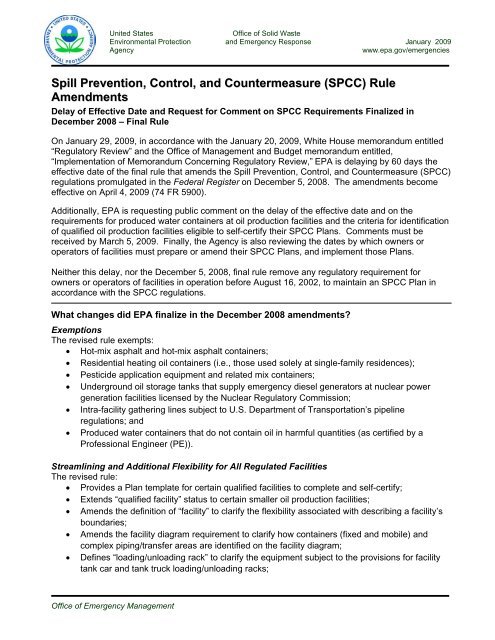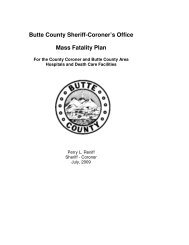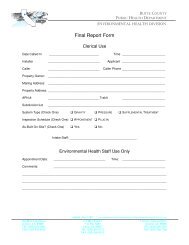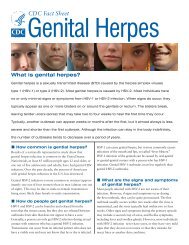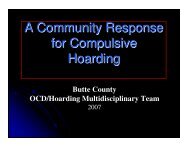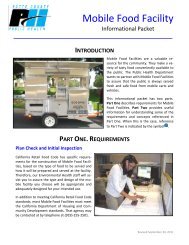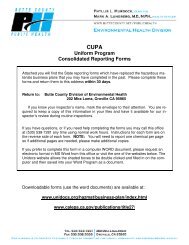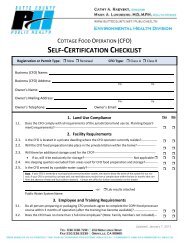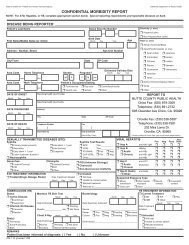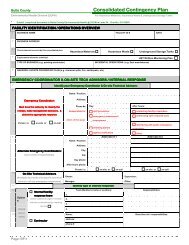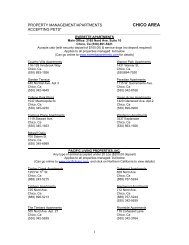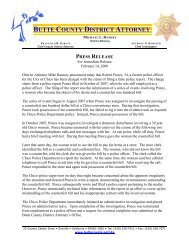Spill Prevention, Control, and Countermeasure - US Environmental ...
Spill Prevention, Control, and Countermeasure - US Environmental ...
Spill Prevention, Control, and Countermeasure - US Environmental ...
Create successful ePaper yourself
Turn your PDF publications into a flip-book with our unique Google optimized e-Paper software.
United States Office of Solid Waste<br />
<strong>Environmental</strong> Protection <strong>and</strong> Emergency Response January 2009<br />
Agency<br />
www.epa.gov/emergencies<br />
<strong>Spill</strong> <strong>Prevention</strong>, <strong>Control</strong>, <strong>and</strong> <strong>Countermeasure</strong> (SPCC) Rule<br />
Amendments<br />
Delay of Effective Date <strong>and</strong> Request for Comment on SPCC Requirements Finalized in<br />
December 2008 – Final Rule<br />
On January 29, 2009, in accordance with the January 20, 2009, White House memor<strong>and</strong>um entitled<br />
“Regulatory Review” <strong>and</strong> the Office of Management <strong>and</strong> Budget memor<strong>and</strong>um entitled,<br />
“Implementation of Memor<strong>and</strong>um Concerning Regulatory Review,” EPA is delaying by 60 days the<br />
effective date of the final rule that amends the <strong>Spill</strong> <strong>Prevention</strong>, <strong>Control</strong>, <strong>and</strong> <strong>Countermeasure</strong> (SPCC)<br />
regulations promulgated in the Federal Register on December 5, 2008. The amendments become<br />
effective on April 4, 2009 (74 FR 5900).<br />
Additionally, EPA is requesting public comment on the delay of the effective date <strong>and</strong> on the<br />
requirements for produced water containers at oil production facilities <strong>and</strong> the criteria for identification<br />
of qualified oil production facilities eligible to self-certify their SPCC Plans. Comments must be<br />
received by March 5, 2009. Finally, the Agency is also reviewing the dates by which owners or<br />
operators of facilities must prepare or amend their SPCC Plans, <strong>and</strong> implement those Plans.<br />
Neither this delay, nor the December 5, 2008, final rule remove any regulatory requirement for<br />
owners or operators of facilities in operation before August 16, 2002, to maintain an SPCC Plan in<br />
accordance with the SPCC regulations.<br />
What changes did EPA finalize in the December 2008 amendments<br />
Exemptions<br />
The revised rule exempts:<br />
• Hot-mix asphalt <strong>and</strong> hot-mix asphalt containers;<br />
• Residential heating oil containers (i.e., those used solely at single-family residences);<br />
• Pesticide application equipment <strong>and</strong> related mix containers;<br />
• Underground oil storage tanks that supply emergency diesel generators at nuclear power<br />
generation facilities licensed by the Nuclear Regulatory Commission;<br />
• Intra-facility gathering lines subject to U.S. Department of Transportation’s pipeline<br />
regulations; <strong>and</strong><br />
• Produced water containers that do not contain oil in harmful quantities (as certified by a<br />
Professional Engineer (PE)).<br />
Streamlining <strong>and</strong> Additional Flexibility for All Regulated Facilities<br />
The revised rule:<br />
• Provides a Plan template for certain qualified facilities to complete <strong>and</strong> self-certify;<br />
• Extends “qualified facility” status to certain smaller oil production facilities;<br />
• Amends the definition of “facility” to clarify the flexibility associated with describing a facility’s<br />
boundaries;<br />
• Amends the facility diagram requirement to clarify how containers (fixed <strong>and</strong> mobile) <strong>and</strong><br />
complex piping/transfer areas are identified on the facility diagram;<br />
• Defines “loading/unloading rack” to clarify the equipment subject to the provisions for facility<br />
tank car <strong>and</strong> tank truck loading/unloading racks;<br />
Office of Emergency Management
SPCC Rule Amendments Delay of Effective Date January 2009<br />
• Amends the general secondary containment requirement;<br />
• Exempts non-transportation-related tank trucks from sized secondary containment<br />
requirements;<br />
• Amends the facility security requirements to allow the facility owner/operator to tailor security<br />
measures to the facility’s specific characteristics <strong>and</strong> location; <strong>and</strong><br />
• Amends integrity testing requirements for bulk storage containers to allow greater flexibility in<br />
the use of industry st<strong>and</strong>ards at all facilities.<br />
What sector-specific changes did EPA finalize<br />
Agriculture. The rule exempts pesticide application equipment <strong>and</strong> related mix containers that may<br />
currently be subject to the SPCC rule when crop oil or adjuvant oil are added to formulations. The rule<br />
exempts farms from loading rack requirements. EPA also clarifies that a nurse tank is considered a mobile<br />
refueler, <strong>and</strong>, like other types of mobile refuelers, is exempt from the sized secondary containment<br />
requirements. Additionally, farms are likely to benefit from several of the other amendments finalized in<br />
this rule.<br />
Oil Production Facilities. The revised rule finalizes several amendments to tailor the requirements<br />
for oil production facilities. The rule:<br />
• Modifies the definition of production facility;<br />
• Extends the timeframe by which a new oil production facility must prepare <strong>and</strong> implement an<br />
SPCC Plan;<br />
• Establishes alternative criteria for certain marginal, oil production facilities to be eligible to selfcertify<br />
an SPCC Plan as a qualified facility;<br />
• Exempts certain produced water containers <strong>and</strong> any associated piping <strong>and</strong> appurtenances<br />
downstream from the container that do not contain oil in harmful quantities, as certified by a<br />
PE;<br />
• Exempts production facilities from loading rack requirements;<br />
• Provides an alternative option for flow-through process vessels to comply with the general<br />
secondary containment requirement <strong>and</strong> additional oil spill prevention measures in lieu of<br />
sized secondary containment requirements;<br />
• Exempts certain intra-facility gathering lines subject to the U.S. Department of<br />
Transportation’s (DOT’s) pipeline regulations;<br />
• Provides an optional exemption from all secondary containment requirements for flowlines<br />
<strong>and</strong> intra-facility gathering lines, <strong>and</strong> establishes more specific requirements for a<br />
flowline/intra-facility gathering line maintenance program <strong>and</strong> contingency planning;<br />
• Provides compliance alternatives to sized secondary containment for produced water storage<br />
containers that are not otherwise exempt; <strong>and</strong><br />
• Clarifies the definition of “permanently closed.”<br />
Animal Fats <strong>and</strong> Vegetable Oils. EPA has amended the integrity testing requirements for<br />
containers storing certain types of animal fat or vegetable oil, to provide the flexibility to determine the<br />
scope of integrity testing that is appropriate, based on compliance with certain FDA regulations <strong>and</strong><br />
other criteria.<br />
Qualified Facilities. EPA streamlined <strong>and</strong> tailored the SPCC requirements for a subset of qualified<br />
facilities. The owner or operator of a qualified facility has the option to self-certify his SPCC Plan <strong>and</strong><br />
comply with other streamlined requirements. This final rule designates a subset of qualified facilities<br />
(“Tier I qualified facilities”) as those that meet the current qualified facilities eligibility criteria <strong>and</strong> that<br />
have no individual aboveground oil storage containers with a capacity greater than 5,000 U.S.<br />
Office of Emergency Management
SPCC Rule Amendments Delay of Effective Date January 2009<br />
gallons. A Tier I qualified facility has the option to complete a self-certified SPCC Plan template<br />
instead of a full SPCC Plan. By completing the SPCC Plan template, an owner or operator of a Tier I<br />
qualified facility will certify that the facility complies with a set of streamlined SPCC rule requirements.<br />
All other qualified facilities will be designated “Tier II qualified facilities.”<br />
Who is subject to the SPCC rule<br />
The SPCC rule applies to owners or operators of non-transportation-related facilities that:<br />
• Drill, produce, store, process, refine, transfer, distribute, use, or consume oil or oil products; <strong>and</strong><br />
• Could reasonably be expected to discharge oil to U.S. navigable waters or adjoining shorelines.<br />
Facilities are subject to the rule if they meet at least one of the following capacity thresholds:<br />
• Aboveground oil storage capacity greater than 1,320 U.S. gallons, or completely buried oil storage<br />
capacity greater than 42,000 U.S. gallons.<br />
The following are exempt from the rule:<br />
• Containers with a storage capacity less than 55 U.S. gallons of oil;<br />
• Permanently closed containers;<br />
• Motive power containers;<br />
• Wastewater treatment facilities;<br />
• Hot-mix asphalt <strong>and</strong> hot-mix asphalt containers;<br />
• Residential heating oil containers;<br />
• Pesticide application equipment <strong>and</strong> related mix containers;<br />
• Produced water containers <strong>and</strong> any associated piping <strong>and</strong> appurtenances downstream of the<br />
container that meet certain criteria;<br />
• Completely buried storage tanks subject to all the technical requirements of the underground storage<br />
tank regulations;<br />
• Intra-facility gathering lines subject to U.S. Department of Transportation’s pipeline regulations; <strong>and</strong><br />
• Underground oil storage tanks at nuclear power generation facilities.<br />
For More Information<br />
Read the final SPCC rule amendment:<br />
http://www.epa.gov/emergencies/content/spcc/spcc_nov08amend.htm<br />
Comment on the final SPCC rule amendment <strong>and</strong> review docket documents:<br />
http://www.regulations.gov. Follow the online instructions to comment on Docket ID No. EPA-HQ-OPA-2007-<br />
0584<br />
Review the Oil Pollution <strong>Prevention</strong> regulation (40 CFR part 112):<br />
http://www.gpoaccess.gov/cfr/<br />
Call the Superfund, TRI, EPCRA, RMP, <strong>and</strong> Oil Information Center:<br />
(800) 424-9346 or (703) 412-9810<br />
TDD (800) 553-7672 or (703) 412-3323<br />
http://www.epa.gov/superfund/resources/infocenter<br />
Call the National Response Center:<br />
(800) 424-8802 or (202) 267-2675<br />
TDD (202) 267-4477<br />
To Report an Oil or Chemical <strong>Spill</strong><br />
Office of Emergency Management


